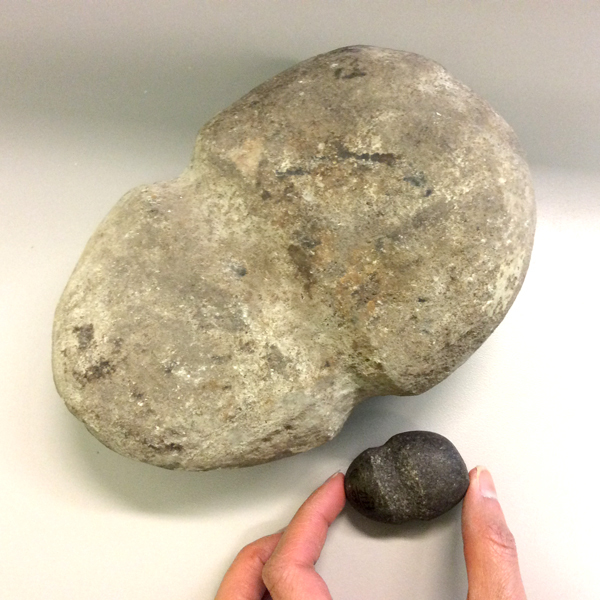
Every so often we see something in the collections here at the museum that gives us what you might call, “a special moment”. That happened recently with our hammerstone collection. There are several hundred hammerstones in it, but we just found one that made us “oooh” and “aahhh” because it was so different from the rest. It was the tiniest hammerstone any of us had ever seen! It can only be described as “cute”! So, some of you might be wondering “what is a hammerstone, anyway”?
Hammerstones, also known as grooved mauls, are found all over the Great Plains, from Texas in the south, to Saskatchewan in the north and even into western and eastern Canada. They are generally, oval-shaped cobblestones that have been modified by using another hard stone to peck a groove around the mid-region of the stone. The groove is pecked so that a handle can be attached. The handle can be attached with leather strapping, as one method. Another method is with a split stick. A branch is cut and peeled and then split at one end, the stone goes between the two split ends and the split stick is tied together with rawhide on both sides of the stone. Sometimes the stones and their handles were covered with raw hide, which was sewn on and left to dry. The hide became tight and hard as it dried and the stone and handle would have been difficult to separate.
What could these implements be used for? Any task that required hammering, pounding or crushing, such as pounding dried meat to make pemmican, or pounding berries to make berry cakes to dry and store for the winter. Animal hides were staked down to the ground for scraping and cleaning as part of the preparation for use. The hammerstones functioned as hammers for driving the stakes into the ground.
Hammerstones could also be used in mines and quarries where various types of stone were extracted for use. There are plenty of places where different types of stone were known to be found and were sought out and mined for tool-making. Hammerstones served as heavy tools for breaking up the rock materials to make flake tools like spear points and dart and arrow points.
There are many, many cobbles all over the Saskatchewan landscapes. People did not usually have to go far to find cobbles to make a hammerstone tool. Did people carry these heavy tools with them when they walked to the next camping spot? Not likely, as another stone could be easily found and a groove pecked around it.
As you can see here, these hammerstones come in all sizes! The tiny stone is very intriguing. Perhaps it was a specialized hammer for fine work in someone’s tool-making kit. But it is so tiny. Could it be a toy? There is very little evidence of children in the archaeological record of the Great Plains. Was this a small tool made for a child to help to learn and practice skills that would be necessary in adult life? If only the stone could tell us its story!

